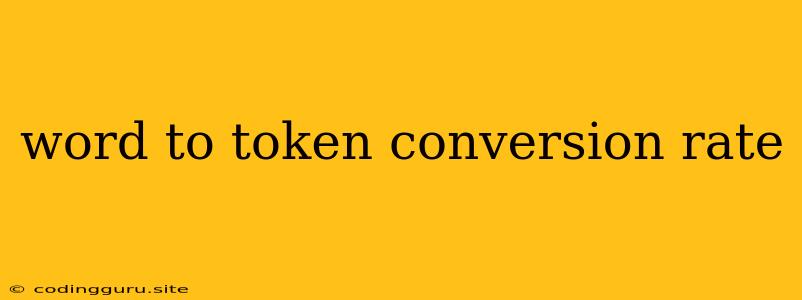Understanding Word to Token Conversion Rate: A Key Metric in NLP
In the realm of natural language processing (NLP), understanding how words are represented as tokens is crucial for effective model training and analysis. The word to token conversion rate is a fundamental metric that quantifies the efficiency of this conversion process. This article delves into the concept of word to token conversion rate, explaining its significance, calculation, and implications for NLP tasks.
What is Word to Token Conversion Rate?
Word to token conversion rate refers to the ratio of the number of unique tokens generated from a given corpus of text to the total number of unique words in that corpus. In simpler terms, it measures how effectively words are being represented as distinct tokens during the tokenization process.
Why is Word to Token Conversion Rate Important?
The word to token conversion rate plays a critical role in NLP because it reflects the complexity and richness of the language being analyzed. A higher conversion rate indicates a greater diversity of words and a potentially more challenging task for NLP models.
Here's why this metric matters:
- Model Complexity: A high word to token conversion rate often suggests a more complex language model is required to capture the nuances of the data.
- Vocabulary Size: This metric directly influences the vocabulary size used for model training, impacting computational resources and training time.
- Feature Engineering: Understanding the conversion rate helps inform feature engineering decisions, particularly when dealing with sparse or complex data.
How to Calculate Word to Token Conversion Rate
To calculate the word to token conversion rate, you need to follow these steps:
- Identify Unique Words: Count the total number of unique words in your corpus.
- Generate Unique Tokens: Tokenize the corpus and count the total number of unique tokens generated.
- Calculate the Ratio: Divide the number of unique tokens by the number of unique words.
For example:
Let's say you have a corpus containing 1000 unique words and after tokenization, you obtain 1200 unique tokens. The word to token conversion rate would be:
Conversion Rate = (Number of Unique Tokens) / (Number of Unique Words)
Conversion Rate = 1200 / 1000
Conversion Rate = 1.2
This indicates that for every unique word in the corpus, 1.2 unique tokens are generated.
Factors Affecting Word to Token Conversion Rate
Several factors can influence the word to token conversion rate:
- Tokenization Strategy: The chosen tokenization method (e.g., word-based, subword-based) can significantly impact the conversion rate.
- Language Complexity: Languages with complex morphology or a rich vocabulary tend to have higher conversion rates.
- Data Preprocessing: Steps like stemming, lemmatization, and stop word removal can affect the final conversion rate.
Interpreting the Word to Token Conversion Rate
The interpretation of the word to token conversion rate depends on the context and the NLP task at hand.
- High Conversion Rate ( > 1.0 ): This typically suggests a diverse vocabulary and potentially complex language structure. It could also indicate the use of subword-based tokenization, which generates more tokens for a given word.
- Low Conversion Rate ( < 1.0 ): This could imply a simpler language structure, a small vocabulary, or the use of a strict word-based tokenization approach.
Optimizing Word to Token Conversion Rate
While the conversion rate itself is not a direct optimization target, understanding its implications allows for better NLP model design and training.
Here are some tips for optimizing the conversion rate:
- Choose an appropriate tokenization method. Subword-based tokenization can be beneficial for handling unknown words and reducing vocabulary size.
- Experiment with different data preprocessing techniques. Removing stop words and applying stemming or lemmatization might lead to a lower conversion rate but can improve model performance.
- Consider using a vocabulary pruning technique. This can help reduce the number of unique tokens without significantly impacting model accuracy.
Conclusion
The word to token conversion rate is an essential metric for NLP practitioners, providing insights into the complexity of the language being analyzed and the efficiency of the tokenization process. By understanding this metric, you can make informed decisions about model design, data preprocessing, and feature engineering, ultimately leading to better NLP model performance. Remember to consider the context of your NLP task and the specific characteristics of your data when interpreting the conversion rate and making decisions about your model.
